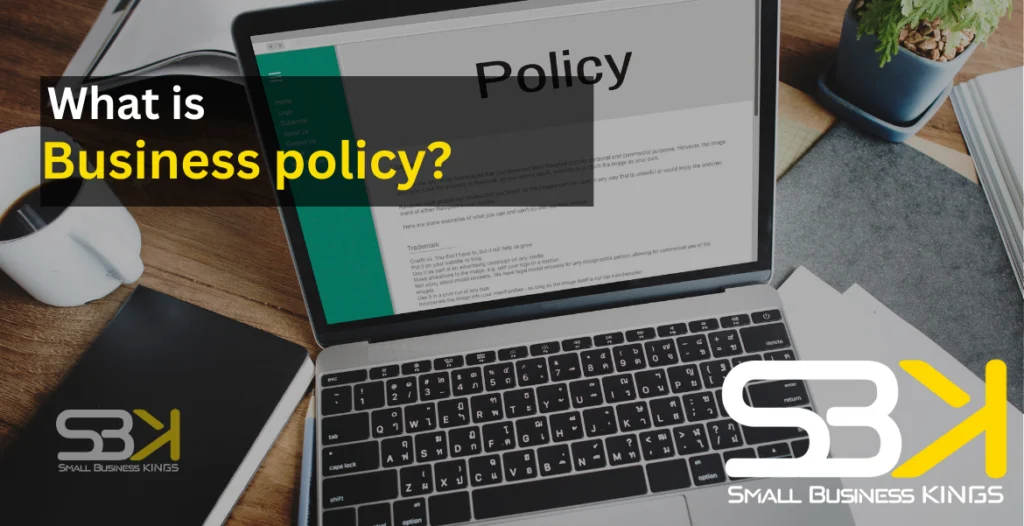Business policy is a crucial aspect of organizational management that guides decision-making processes and actions within a company.
It encompasses a set of guidelines, rules, and procedures formulated by the management to achieve specific objectives and goals effectively.
Business policy provides a framework for consistency and coherence in the organization’s operations, ensuring alignment with its overall mission and vision.
Importance of Business Policy

Business policy plays a pivotal role in the success and sustainability of any organization.
By providing clarity, direction, and consistency, it ensures that all stakeholders understand the objectives, goals, and procedures of the organization.
This facilitates efficient resource allocation, risk management, and conflict resolution, ultimately contributing to the company’s growth, profitability, and sustainability.
In essence, business policy acts as a roadmap, steering the organization towards its desired outcomes and helping to maintain coherence amidst dynamic business environments.
Types of Business Policy
Business policies can be classified into various types, each serving distinct functions within the organization:
- General Policies: These are overarching principles that apply across the entire organization, encompassing its core values, ethics, and cultural norms. General policies set the tone for the organizational culture and provide a foundation for decision-making and behavior.
- Functional Policies: Functional policies are specific to particular departments or functional areas within the organization, such as marketing, finance, human resources, and operations. These policies address the unique challenges and requirements of each department, guiding their day-to-day operations and strategic initiatives.
- Specific Policies: Specific policies address particular issues or situations within the organization, such as employee conduct, safety protocols, and customer service standards. These policies offer detailed guidelines and procedures for handling specific tasks or scenarios, ensuring consistency and compliance across the organization.
Components of Business Policy
Vision and Mission Statements
The vision and mission statements articulate the organization’s purpose, values, and long-term aspirations, guiding its strategic direction and decision-making processes.
Objectives and Goals
Objectives and goals delineate the desired outcomes and milestones that the organization aims to achieve within a specified timeframe, serving as benchmarks for performance evaluation.
Strategies
Strategies outline the broad approach or course of action adopted by the organization to attain its objectives, encompassing resource allocation, market positioning, and competitive advantage.
Procedures
Procedures define the sequential steps or processes to be followed in executing various tasks or activities within the organization, ensuring consistency and efficiency in operations.
Rules
Rules establish the norms, standards, and regulations governing employee behavior, conduct, and interactions within the organization, fostering discipline and orderliness.
Guidelines
Guidelines provide recommendations or best practices for decision-making and problem-solving in specific situations, offering a framework for effective decision-making.
Learn More: What is QRG in Business? Quick Reference Guide Meaning & Use
How to Create a Business Policy?
The formulation of business policy involves several key steps:
- Assess the Need: Determine the specific area or issue for which a policy is needed. This could range from employee conduct to data security protocols.
- Research and Analysis: Conduct research to gather relevant information about the topic. This may involve studying industry best practices, regulatory requirements, and internal processes.
- Define Objectives: Clearly define the objectives that the policy aims to achieve. These objectives should be specific, measurable, achievable, relevant, and time-bound (SMART).
- Draft the Policy: Write the policy document, outlining the purpose, scope, and guidelines. Ensure that the language is clear, concise, and easy to understand. Include sections such as policy statement, applicability, responsibilities, procedures, and consequences for non-compliance.
- Consult Stakeholders: Seek input and feedback from relevant stakeholders, including employees, managers, legal experts, and regulatory authorities. Incorporate their perspectives to ensure the policy’s effectiveness and buy-in.
- Review and Revise: Review the draft policy to identify any gaps, inconsistencies, or ambiguities. Revise the document as necessary to address feedback and ensure alignment with organizational goals and values.
- Approval Process: Present the revised policy for approval to the appropriate authorities or decision-makers within the organization. Obtain sign-off to formalize the policy and establish accountability for its implementation.
- Communicate the Policy: Communicate the new policy to all stakeholders, ensuring that they understand their roles, responsibilities, and expectations. Provide training and support as needed to facilitate compliance.
- Implementation Plan: Develop an implementation plan that outlines the steps, timelines, and resources required to put the policy into action. Assign roles and responsibilities to designated individuals or teams responsible for enforcement and monitoring.
- Monitor and Evaluate: Continuously monitor the implementation of the policy to assess its effectiveness and identify any areas for improvement. Solicit feedback from stakeholders and adjust the policy as necessary to address emerging issues or changing needs.
Difference Between Business Policy and Strategy
Business policy refers to a set of guidelines, rules, and procedures established by an organization to guide decision-making and actions at all levels. Strategy, on the other hand, refers to a comprehensive plan or course of action designed to achieve specific objectives and goals, and to gain a competitive advantage in the marketplace.
While business policy and strategy are closely related concepts, they serve distinct purposes:
Business policy focuses on establishing guidelines and procedures for decision-making and action within the organization, whereas strategy involves formulating plans and tactics to achieve specific objectives and gain a competitive advantage in the marketplace.
Their key differences are as follows:
- Scope: Business policy deals with internal organizational matters, such as rules, procedures, and guidelines, while strategy addresses external market dynamics and competitive positioning.
- Time Horizon: Business policy tends to be more focused on short-term operational concerns, while strategy is concerned with long-term planning and direction-setting.
- Level of Detail: Business policy is often more detailed and prescriptive, providing specific guidelines and procedures for decision-making and action, while strategy tends to be more conceptual and high-level, focusing on overall direction and objectives.
Considerations During Business Policy Implementation
Despite its importance, business policy implementation may face several challenges:
Resistance to Change
One of the most common challenges in business policy implementation is resistance to change from employees, stakeholders, or even organizational culture. People are often accustomed to existing practices and may resist adopting new policies, especially if they perceive them as disrupting established routines or threatening their interests.
Lack of Understanding
Unclear or ambiguous policies can lead to confusion, misinterpretation, and inconsistent application. When policies lack clarity in their objectives, scope, or procedures, employees may struggle to understand their roles and responsibilities, resulting in inefficiency, errors, or conflicts.
External Factors
External factors such as regulatory changes, market volatility, economic uncertainties, or technological disruptions can pose significant challenges to business policy implementation. Organizations may need to adapt their policies and practices in response to external pressures, which can be time-consuming, resource-intensive, and disruptive to operations
Resource Constraints
Limited resources, including time, budget, and manpower, can impede the effective implementation of business policies. Organizations may struggle to allocate sufficient resources for training, communication, and monitoring, resulting in incomplete or inadequate implementation efforts.
Organizational Culture
Organizational culture plays a crucial role in shaping attitudes, behaviors, and norms within the organization. If the existing culture is resistant to change or does not align with the objectives of new policies, implementation efforts may face significant resistance or pushback from employees and stakeholders.
FAQs
- What is the difference between business policy and strategy?
Business policy focuses on establishing guidelines and procedures for decision-making within the organization, while strategy involves formulating plans and tactics to achieve specific objectives and gain a competitive advantage.
- How are business policies formulated?
Business policies are formulated through environmental analysis, strategic planning, policy implementation, and monitoring and evaluation processes.
- What are the key components of business policy?
The key components of business policy include vision and mission statements, objectives and goals, strategies, procedures, rules, and guidelines.
- Why is business policy important for organizations?
Business policy provides clarity, direction, and consistency in organizational operations, enabling efficient resource allocation, risk management, and decision-making.
- What are some challenges in business policy implementation?
Challenges in business policy implementation may include resistance to change, lack of clarity, and external factors such as market volatility and regulatory changes.


